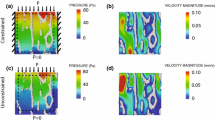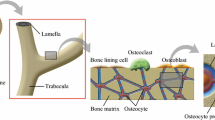Abstract
Since cancellous bone remodeling is active compared to cortical bone, the fluid communications for the metabolism of osteocytes between the inter-trabecular and intra-trabecular pores should be active compared to those between the vascular and lacunocanalicular pores in osteons. In this study, the permeability coefficient of trabeculae of human proximal femur in the direction of superior-to-fovea is estimated by using the isotropic poroelasticity. Using the pore pressure solution in the drained uniaxial strain condition and the poroelastic properties of trabeculae, effects of the permeability coefficient in the direction of superior-to-fovea on intra-trabecular fluid pressure generation are investigated. In the range of the applied permeability coefficient from 10−15 to 10−10 m2/kPa-sec, the predicted maximum intra-trabecular fluid pressure was 754 kPa. The predicted range of intrinsic permeability is from 10−21 to 10−16 m2 when 0.001 Pa-sec of the dynamic viscosity of serum is used. The predicted permeability values are larger than those for cortical tissues. It was reported that the mean lacuna volumes of trabeculae and cortical tissue in the human femur ranged from 445 to 488 µm 3 and from 389 to 408µm 3, respectively.
The original version of this chapter was inadvertently published with an incorrect chapter pagination 679–681 and DOI 10.1007/978-3-319-32703-7_131. The page range and the DOI has been re-assigned. The correct page range is 685–687 and the DOI is 10.1007/978-3-319-32703-7_132. The erratum to this chapter is available at DOI: 10.1007/978-3-319-32703-7_260
An erratum to this chapter can be found at http://dx.doi.org/10.1007/978-3-319-32703-7_260
Access this chapter
Tax calculation will be finalised at checkout
Purchases are for personal use only
Similar content being viewed by others
References
Jee WSS. (1990) The skeletal tissue. In Cell and Tissue Biology: A Textbook of Histology, L Weiss Edited, Urban and Schwarzenberg, Baltimore, 200
Rice JR, Cleary MP. (1976) Some basic stress-diffusion solutions for fluid saturated elastic porous media with compressible constituents. Res Geophys Space Phys 14: 227-241
Kim H, Chae S, Lim T-H, Hong J. Measurement of intra-trabecular fluid pressure of human proximal femoral trabeculae. In preparation of an article to submit to JOR
Lim T-H, Hong JH. (1998) Poroelastic model of trabecular bone in uniaxial strain condition. J Musculoskeletal Res. 2: 167-180
Cardoso L, Fritton SP, Gailani G, et al. (2013) Advances in assessment of bone porosity, permeability and interstitial fluid flow. J Biomech, 46: 253-265
McCreadie BR, Hollister SJ, Schaffler MB, et al. (2004) Osteocyte lacuna size and shape in women with and without osteoporotic fracture. Journal of Biomechanics 37: 563–572
Carter Y, Thomas CDL, Clement JG, et al. (2013) Variation in osteocyte lacunar morphology and density in the human femur—a synchrotron radiation micro-CT study. Bone, 52: 126-132
Beno T, Yoon YJ, Cowin SC, et al. (2006) Estimation of bone permeability using accurate Microstructural measurements. Journal of Biomechanics 39: 2378–2387
Scheidegger AE. (1957) The physics of flow through porous media. University of Toronto Press
Author information
Authors and Affiliations
Corresponding author
Editor information
Editors and Affiliations
Rights and permissions
Copyright information
© 2016 Springer International Publishing Switzerland
About this paper
Cite this paper
Kim, H. et al. (2016). Permeability Prediction of Human Proximal Femoral Trabeculae in the Direction of Superior-to-Fovea Utilizing Directly Measured Microscopic Poroelastic Properties. In: Kyriacou, E., Christofides, S., Pattichis, C. (eds) XIV Mediterranean Conference on Medical and Biological Engineering and Computing 2016. IFMBE Proceedings, vol 57. Springer, Cham. https://doi.org/10.1007/978-3-319-32703-7_132
Download citation
DOI: https://doi.org/10.1007/978-3-319-32703-7_132
Published:
Publisher Name: Springer, Cham
Print ISBN: 978-3-319-32701-3
Online ISBN: 978-3-319-32703-7
eBook Packages: EngineeringEngineering (R0)




